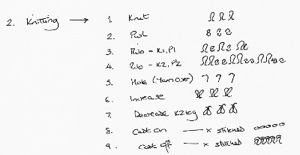The Experiments
Evolutionary Experiment - Codes
19/11/07 20:30
Evolutionary Experiment - Variation
18/11/07 20:05
Textile process - crochet - knit - needlelace
Stitch - will vary according to process
Form - start with sphere – disk – tube – spiral – pyramid
Dimensions - number of stitches – rows - iterations
Materials
Colour
Surface modifications
picot – spike – loop – frill – ridge
hole – indentation – raised
found objects
wax – paint – varnish
Each variable will have either a discreet series or range of values eg. rows / stitches will have values with upper / lower limits, while process will have values of knit, crochet or needlelace.
The preliminary experiment will confirm or modify the variables and their values. Sampling might be part or a complete specimen, enough to see what works.
Stitch size and tools (hook / needlesize) will be determined by the sampler.
Stitch - will vary according to process
Form - start with sphere – disk – tube – spiral – pyramid
Dimensions - number of stitches – rows - iterations
Materials
Colour
Surface modifications
picot – spike – loop – frill – ridge
hole – indentation – raised
found objects
wax – paint – varnish
Each variable will have either a discreet series or range of values eg. rows / stitches will have values with upper / lower limits, while process will have values of knit, crochet or needlelace.
The preliminary experiment will confirm or modify the variables and their values. Sampling might be part or a complete specimen, enough to see what works.
Stitch size and tools (hook / needlesize) will be determined by the sampler.
Evolutionary Experiment - Ideas
17/11/07 19:24
Ideas – genetics, dna, mutation, inheritance, natural selection, evolution
Rules – variables such as technique (process?), dimensions, form, pattern with discreet limits
Mutation – Chance – random generator of values for rules
Genetic code – assign codes to stitch types, diagrammatic interpretations of pattern
Selection – viability and aesthetic choices
Evolution – selected specimens as starting point for next generation
Classification – identify relationships, naming
Documentation – pattern, stages of development (photography)
Rules – variables such as technique (process?), dimensions, form, pattern with discreet limits
Mutation – Chance – random generator of values for rules
Genetic code – assign codes to stitch types, diagrammatic interpretations of pattern
Selection – viability and aesthetic choices
Evolution – selected specimens as starting point for next generation
Classification – identify relationships, naming
Documentation – pattern, stages of development (photography)
The Experiments
16/11/07 18:53
The work takes the form of a series of experiments exploring the idea of mutation to evolve new textile ‘life forms’. The principles of generative art are used to create a series of rules that determine the shape and form of organic 'specimens'. Variables of size, shape, sequence and number have aleatory values, ie. generated randomly.



